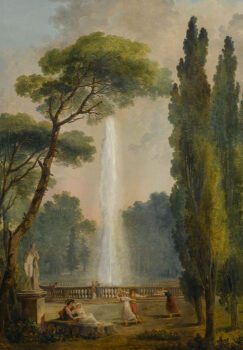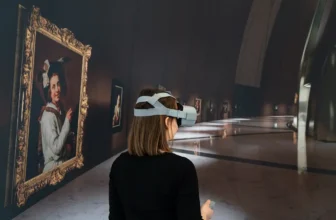Meaning of View of a Garden with a Large Fountain Painting
Amid the rich tapestry of 18th-century European art, an artist emerges as a master of romantic ruins, imaginative architecture, and evocative garden landscapes, Hubert Robert. Among his many captivating works, “View of a Garden with a Large Fountain” stands as a testament to his visionary imagination and love for classical antiquity. Painted in the latter part of the 18th century, this work is more than a mere landscape; it is an architectural fantasy, a meditation on nature, beauty, and the passage of time.
This article explores the story behind this exquisite painting: its aesthetic dimensions, symbolic language, artistic style, creation process, historical context, and current location. Let’s take a journey into the heart of a garden imagined by Hubert Robert, where the past and present intermingle, and fountains whisper the poetry of time.
Who Was Hubert Robert? A Romantic Visionary
Before delving into the painting itself, it is essential to understand the mind behind it. Hubert Robert (1733–1808) was a French painter and draftsman celebrated for his capricci, imaginative compositions that mixed real and imagined architectural elements. Nicknamed “Robert des ruines,” he had an enduring fascination with ancient Roman ruins and gardens, which he often rendered with a romantic flair.
Robert studied in Rome from 1754 to 1765, absorbing the grandeur of ancient monuments and the serene compositions of Italian gardens. He was profoundly influenced by Giovanni Paolo Panini and Giovanni Battista Piranesi, whose work shaped his distinctive vision. Returning to France, Robert became the official designer of the King’s gardens, particularly at Versailles, and was later appointed Curator of the Louvre. His art blends topographical accuracy with emotional resonance, invoking nostalgia, reflection, and often a gentle melancholy.
What Is “View of a Garden with a Large Fountain” All About?
At first glance, “View of a Garden with a Large Fountain” seems to depict a tranquil, sun-dappled garden with classical elements. A majestic fountain gushes in the foreground, surrounded by symmetrically arranged trees, balustrades, and ornamental statuary. The garden, possibly inspired by Versailles or one of the Italian Renaissance villas, is populated with figures: elegantly dressed visitors, perhaps aristocrats, strolling and conversing, and attendants tending to the space.
However, beneath this seemingly idyllic scene lies a complex interplay of artificiality and nature, memory and monument, and ephemeral beauty and timeless grandeur. Robert’s work was not a reproduction of a specific garden but a constructed ideal, synthesizing the elegance of French formal gardens with the fantasy of imagined antiquity.
The Artistic Style: Capriccio and the Picturesque
The painting is a classic example of a capriccio, an architectural fantasy that combines real-world and imagined elements into a coherent, often emotionally evocative scene. Hubert Robert’s “View of a Garden with a Large Fountain” exemplifies this tradition, blending Neoclassical architecture with pastoral landscapes and romantic ruins, though in this case, the ruins are more implied than explicit.
The style is both Neoclassical, in its reverence for order, geometry, and antiquity, and picturesque, evoking nature as a scene to be experienced and contemplated. This duality allows viewers to oscillate between intellectual admiration for classical forms and emotional immersion in the ambiance of the scene.
The brushwork is loose yet precise, capturing texture and light without overworking details. Robert’s control over atmospheric perspective, the fading of color and clarity in the distance, adds depth and a sense of serenity.
How Was the Painting Created? Techniques and Inspiration
Robert likely painted this work in his studio, using a combination of sketches from real gardens and architectural studies from his time in Rome and France. He was known for making quick, evocative pen-and-ink sketches on location, which he would later develop into oil paintings. These were not merely factual reproductions, but idealized visions, shaped by memory and imagination.
The fountain, a central motif, may have been inspired by the Fountain of Apollo at Versailles, the Villa d’Este in Tivoli, or the Fountain of the Four Rivers in Rome. The use of perspective lines, classical architectural motifs (columns, urns, balustrades), and human figures reveal his training as an architectural draftsman as much as a painter.
He used oil on canvas, a medium that allowed him to explore nuances in light, water, and stone. The composition unfolds horizontally, drawing the eye along the garden path toward a central architectural structure, possibly a folly or a temple, which anchors the piece.
What’s Happening in the Painting? A Moment Frozen in Time
The painting captures a typical afternoon in an idealized garden, sunlit, orderly, and serene. Several narratives unfold simultaneously:
Elegant women and men stroll along manicured paths, suggesting leisure and refined conversation, hallmarks of aristocratic life in 18th-century France.
Children play near the fountain, imbuing the scene with life and innocence.
Servants or gardeners tend to the surroundings, reminding viewers of the human labor behind such artificial paradises.
Birds fly overhead, and the trees sway gently, emphasizing the harmony between human design and nature.
Yet, the scene also evokes a feeling of quiet reflection. The fountain, the focal point, represents movement within stillness, a dynamic element amidst a carefully ordered space. It symbolizes the passage of time, as water flows endlessly, indifferent to the humans who admire or ignore it.
Symbolism and Meaning: More Than Just a Garden
The Fountain as a Metaphor
The central fountain symbolizes life, abundance, and impermanence. Water, as a classical symbol, stands for both renewal and ephemeral beauty. In Roman and Renaissance iconography, fountains were often allegories for the source of knowledge, power, or divine grace.
Here, the large fountain suggests a wellspring of culture and memory, placed in a garden of controlled nature. The water arcs upward before descending, a possible metaphor for human ambition and inevitable decline, themes consistent with Robert’s other works on ruins and decay.
The Garden as Utopia
The formal garden is not just a place of beauty but an expression of human dominion over nature. In the Enlightenment context, such gardens represented reason, harmony, and classical ideals. But Robert’s vision is tinged with gentle irony: nature, though shaped and trimmed, always resists total control, and beauty, though celebrated, is always transient.
Figures as Social Commentary
The inclusion of aristocratic figures engaging in leisurely activities may hint at the detachment of the elite from the real world, a subtle critique, especially poignant in the decades leading to the French Revolution. Robert himself was imprisoned during the Reign of Terror, and his art often reflects a world of fragile opulence on the verge of transformation.
What Type of Art Is It? Genre and Classification
“View of a Garden with a Large Fountain” can be classified as:
Landscape Painting: Specifically, a garden landscape focusing on architectural harmony and natural beauty.
Capriccio: Combining real and imagined elements, not tied to a specific location.
Architectural Fantasy: Celebrating form, proportion, and imagined structures.
Genre Painting (lightly): Through its depiction of people in a leisurely setting.
It straddles the line between Neoclassicism (in form and structure) and Rococo (in mood and elegance), but ultimately leans toward the Romantic fascination with the passage of time and the blending of man-made and natural beauty.
Where Is The Painting Today?
“View of a Garden with a Large Fountain” by Hubert Robert is currently housed in the Getty Center in Los Angeles, part of the J. Paul Getty Museum’s European painting collection. The museum acquired the painting for its exceptional quality, historical value, and exemplary representation of Robert’s unique vision.
Visitors to the Getty can see the painting in a setting that reflects its historical context, often accompanied by other 18th-century French artworks, garden plans, and architectural drawings. The Getty Center also provides educational materials that delve into Robert’s life, the symbolism in his work, and the broader culture of 18th-century European garden design.
Legacy and Relevance Today
Hubert Robert’s “View of a Garden with a Large Fountain” is more than a visual pleasure, it is a lens through which we can understand 18th-century French culture, the aesthetics of nature, and philosophical reflections on time and decay.
In an era where environmental control, artificial beauty, and curated experiences dominate modern life, Robert’s painting feels unexpectedly contemporary. It poses subtle questions: What is our relationship with nature? Do we create beauty or merely frame it? Can we escape time through art, or does art remind us of time’s quiet passage?
These themes remain as relevant today as they were over two centuries ago.
Hubert Robert’s “View of a Garden with a Large Fountain” is a masterwork of poetic vision, architectural elegance, and philosophical depth. It invites viewers not just to admire, but to reflect, to wander mentally through a space that is at once real and imagined, timeless yet fleeting.
Through fountains that echo eternity and gardens trimmed to perfection, Robert gives us a paradise tinged with loss, a moment of joy painted with the colors of memory. In this luminous garden, we find not just beauty, but a profound meditation on art, time, and the fragile grandeur of human creation.
Whether you view it on the walls of the Getty Museum or through a digital screen, this painting continues to inspire wonder, contemplation, and a deep appreciation for the harmony of art and nature.




